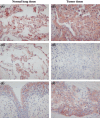Infrequent hypermethylation of the PTEN gene in Korean non-small-cell lung cancers
- PMID: 20175786
- PMCID: PMC11159311
- DOI: 10.1111/j.1349-7006.2009.01406.x
Infrequent hypermethylation of the PTEN gene in Korean non-small-cell lung cancers
Abstract
CpG islands (CGIs) hypermethylation is implicated in the pathogenesis of many cancers, including lung cancer. The phosphate and tension homolog (PTEN) is a tumor suppressor that controls a variety of biological processes including cell proliferation, growth, migration, and death. The defects in PTEN regulation have a profound impact on carcinogenesis. Herein, we have examined the methylation status of the human PTEN gene in 137 primary non-small-cell lung cancers (NSCLCs) by using a methylation-specific PCR and correlated the results with clinicopathological features. Promoter methylation of the PTEN gene was observed in 5.1%, 2.9%, and 0.0% of three different CpG regions, which were localized at -1460 to -1263, -984 to -848, and -300 to -128 nucleotides upstream of the translation start site, respectively. Reverse transcription-PCR and immunohistochemical analysis showed the methylation of the CGI region at -984 to -848 correlated more accurately with PTEN expression. In addition, no significant correlation was found between PTEN methylation and clinicopathological factors, including the survival rates. These findings suggest that promoter methylation is not an important mechanism for PTEN deregulation in NSCLCs from Koreans.
Figures



Similar articles
-
PTEN, RASSF1 and DAPK site-specific hypermethylation and outcome in surgically treated stage I and II nonsmall cell lung cancer patients.Int J Cancer. 2010 Apr 1;126(7):1630-9. doi: 10.1002/ijc.24896. Int J Cancer. 2010. PMID: 19795445
-
Epigenetic inactivation of checkpoint kinase 2 gene in non-small cell lung cancer and its relationship with clinicopathological features.Lung Cancer. 2009 Aug;65(2):247-50. doi: 10.1016/j.lungcan.2009.03.011. Epub 2009 Apr 11. Lung Cancer. 2009. PMID: 19362748
-
CpG hypermethylation contributes to decreased expression of PTEN during acquired resistance to gefitinib in human lung cancer cell lines.Lung Cancer. 2015 Mar;87(3):265-71. doi: 10.1016/j.lungcan.2015.01.009. Epub 2015 Jan 20. Lung Cancer. 2015. PMID: 25638724
-
Lack of PTEN expression in non-small cell lung cancer could be related to promoter methylation.Clin Cancer Res. 2002 May;8(5):1178-84. Clin Cancer Res. 2002. PMID: 12006535
-
PTEN hypermethylation profiles of Chinese Kazakh patients with esophageal squamous cell carcinoma.Dis Esophagus. 2014 May-Jun;27(4):396-402. doi: 10.1111/dote.12106. Epub 2013 Aug 27. Dis Esophagus. 2014. PMID: 23980519
Cited by
-
PTEN gene is infrequently hypermethylated in human esophageal squamous cell carcinoma.Tumour Biol. 2015 Aug;36(8):5849-57. doi: 10.1007/s13277-015-3256-y. Epub 2015 Feb 28. Tumour Biol. 2015. PMID: 25724185
-
Prognostic value of Iroquois homeobox 1 methylation in non-small cell lung cancers.Genes Genomics. 2020 May;42(5):571-579. doi: 10.1007/s13258-020-00925-9. Epub 2020 Mar 21. Genes Genomics. 2020. PMID: 32200543
-
Hypermethylation of normal mucosa of esophagus-specific 1 is associated with an unfavorable prognosis in patients with non-small cell lung cancer.Oncol Lett. 2018 Aug;16(2):2409-2415. doi: 10.3892/ol.2018.8915. Epub 2018 Jun 6. Oncol Lett. 2018. PMID: 30013631 Free PMC article.
-
Association of CCND1 overexpression with KRAS and PTEN alterations in specific subtypes of non-small cell lung carcinoma and its influence on patients' outcome.Tumour Biol. 2015 Nov;36(11):8773-80. doi: 10.1007/s13277-015-3620-y. Epub 2015 Jun 9. Tumour Biol. 2015. PMID: 26055143
-
Identification of a subset of human non-small cell lung cancer patients with high PI3Kβ and low PTEN expression, more prevalent in squamous cell carcinoma.Clin Cancer Res. 2014 Feb 1;20(3):595-603. doi: 10.1158/1078-0432.CCR-13-1638. Epub 2013 Nov 27. Clin Cancer Res. 2014. PMID: 24284056 Free PMC article.
References
-
- Li L, Ross AH. Why is PTEN an important tumor suppressor? J Cell Biochem 2007; 102: 1368–74. - PubMed
-
- Yin Y, Shen WH. PTEN: a new guardian of the genome. Oncogene 2008; 27: 5443–53. - PubMed
-
- Eng C. PTEN: one gene, many syndromes. Hum Mutat 2003; 22: 183–98. - PubMed
-
- Alvarez‐Nunez F, Bussaglia E, Mauricio D et al. X. PTEN promoter methylation in sporadic thyroid carcinomas. Thyroid 2006; 16: 17–23. - PubMed
-
- Mirmohammadsadegh A, Marini A, Nambiar S et al. Epigenetic silencing of the PTEN gene in melanoma. Cancer Res 2006; 66: 6546–52. - PubMed
Publication types
MeSH terms
Substances
LinkOut - more resources
Full Text Sources
Medical
Research Materials

